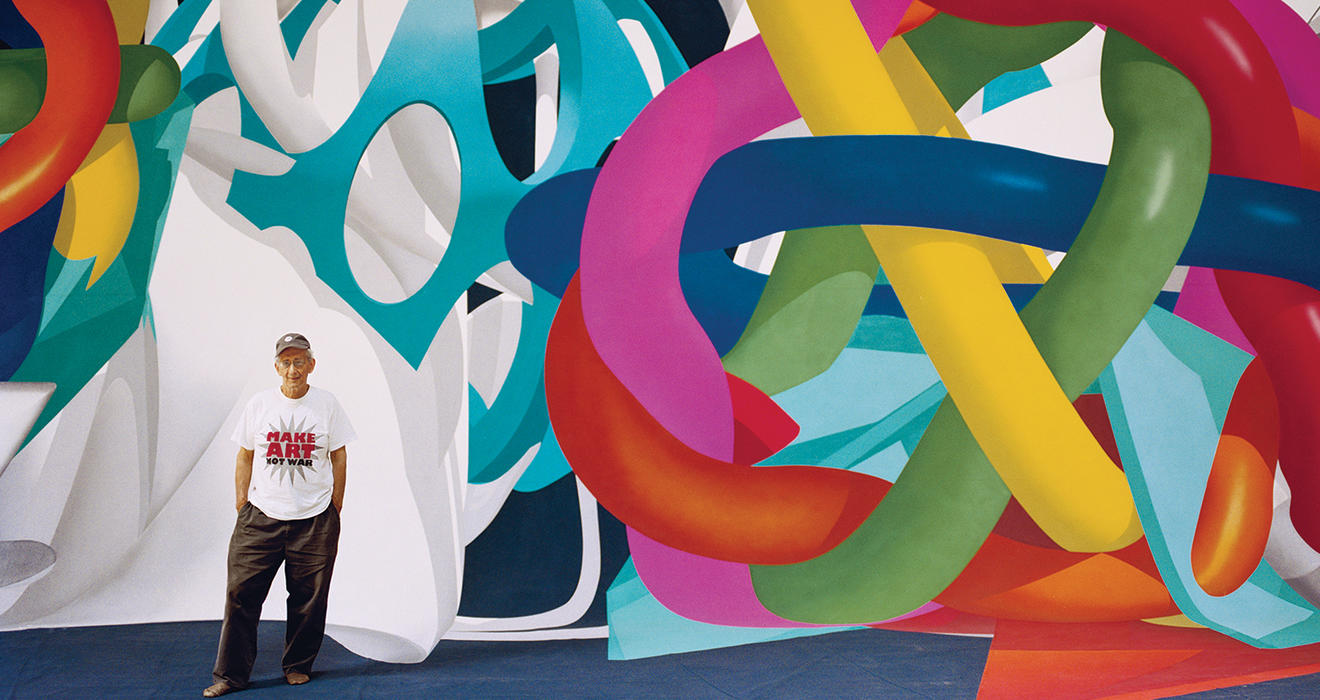
Most artists work their entire lives without achieving the level of fame that Frank Stella ’58 had reached by the age of 23. Only a small handful can survive such fame and continue to develop as artists without being swallowed by it.
In 1959, just months after his graduation from Princeton, four of Stella’s works were included, alongside abstract expressionist luminaries such as Jasper Johns and Robert Rauschenberg, in a group show at the Museum of Modern Art (MoMA). Stella’s contributions turned the art world inside out. The canvasses were huge squares of thick black lines painted with geometric precision using a house painter’s brush, interspersed with thin strips of blank canvas. Though they bore weighty titles such as The Marriage of Reason and Squalor II, the “Black Paintings,” as they came to be known, deliberately presented nothing and seemed to repel efforts to explore them deeply.
Just a year later, Stella was the subject of a one-man show at New York’s prestigious Leo Castelli Gallery.
“He made himself one of the truly important artists of the 20th and 21st centuries,” says Michael Fried ’59, an art historian, critic, and lifelong friend of Stella.
Yet having taken abstract expressionism seemingly to its endpoint, Stella moved on. Over the rest of a career that spanned 65 years, Stella regularly reinvented himself, creating works in a dazzling array of colors, shapes, and materials, defying attempts by critics or the public to pigeonhole him.
“Mr. Stella was a dominant figure in American art,” his obituary in The New York Times said, “a restless, relentless innovator whose explorations of color and form made him an outsize presence, endlessly discussed and constantly on exhibit.” Indeed, MoMA held the first retrospective of Stella’s work in 1970, when he was just 34 (the youngest artist ever so honored), and another just seven years later.
“Stella rattled standards of modernist abstraction rather as Bob Dylan did those of folk music, electrifying the medium,” wrote Peter Schjeldahl in a New Yorker tribute. “Arriving at the all-time peak of American hegemony in world art, Stella was the poster prodigy of a new breed of artists: post-bohemian, university-trained, professional from the get-go.”
Stella’s mother was an illustrator, his father a gynecologist who put himself through medical school by painting houses and enlisted his young son to help him sand and prep. After attending Phillips Academy, Stella majored in history at Princeton and took an early drawing class with William Seitz *55, who later became the curator of MoMA. But Stella had no interest in being an art student; he wanted to be an artist.
“I didn’t want to paint from the model,” he told PAW in a 2006 interview. “I just wanted to make paintings.”
Early in his senior year, Stella visited the Castelli Gallery and saw one of Johns’ famous American flag paintings which, with its flat, repetitive lines, seemed to blur the distinction between painting and object. Back at Princeton, he began trying to respond to what the abstract expressionists were doing.
Passionately committed to his craft throughout his long career, Stella nevertheless brushed aside attempts to glorify it — or him. “My painting is based on the fact that only what can be seen there is there,” he once said in an interview. “What you see is what you see.”
On another occasion, he told critic Deborah Solomon, “If artists want to do something useful, they can be social workers or politicians. Or they can join the U.S. Army. Art does not do what a social worker does. No abstract image is going to help anyone.”
Stella sometimes said that no artist needed to live past the age of 40, suggesting that they had exhausted their creativity by then. His own career, however, disproved that.
Within a few years, he had moved from the brooding black paintings to an explosion of color. His so-called “Protractor Series” of the late ’60s featured large-scale square or pie-shaped canvasses with curved colored bands. Though some were as big as 20 feet across, they looked as though they had been traced with a compass or protractor. Later, Stella abandoned the flatness of the traditional canvas, creating works that jutted into the viewer’s space rather than inviting the viewer in. By the turn of the century, he was creating mixed media prints and huge sculptures, including an aluminum band shell. Some of his final works included star-shaped sculptures created on a computer and even a non-fungible token (NFT).
“He started evolving and not repeating himself so early that that was just his M.O.,” Fried says. “He had a constant drive to do something new.”
His passions often took him outside the studio. In 1983, Stella was invited to give the Charles Eliot Norton lectures at Harvard, a rare honor for an artist. He traced themes of artistic abstraction from the 16th century to the present, eventually turning them into a book, Working Space. Critic Hilton Kramer called it “one of the most remarkable books ever written on the subject.”
A fine natural athlete who wrestled and played lacrosse in college, Stella took up squash in middle age after a back injury left him unable to play tennis. Throwing himself into his new avocation, he built a squash court at his home and organized pro tournaments.
“I’m not tempted to paint squash scenes,” he confessed to Sports Illustrated in a 1986 profile. “All squash has tempted me to do is break my racquet.”
But he never stayed out of the studio for long. “It was nice that he was world famous, but that wasn’t the most important thing to him,” Fried says. “What he cared about was getting the work done.”
How that work would be classified was a problem for others to solve. “Making art is complicated because the categories are always changing,” Stella once said. “You just have to make your own art, and whatever categories it falls into will come later.”
Mark F. Bernstein ’83 is PAW’s senior writer.





No responses yet